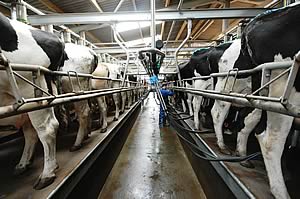28/01/08
For the first time in more than a decade average milk yields have
dropped, according to data on 60% of British dairy cows published
in the latest NMR Annual Production Report for the year ending
September 2007.
However data shows that protein percentage has improved in all
the major dairy breeds while, in many, fat percentage has dropped.
An exception to this is the Holstein and Guernsey breeds where
both fat and protein percentage have increased.
Average somatic cell count (SCC) and calving index continued
to rise across all breeds.
“The fall in milk yield may be the effect of poor forage
fed during the 2006/07 winter,” says NMR national field
manager Jonathan Davies. “This was followed by a wet June
and July in many parts of the country, which again had an adverse
effect on yields. Cell counts and fertility on many units remain
an issue and many producers, working with their vets and advisers,
are taking a more proactive approach to this now. Hopefully we
will see trends reverse in the next few years.”
Led by the Holstein breed, which accounts for 91.7% of all recorded
lactations, average milk yield has dropped by 6kg to 8,264kg.
Meanwhile, both fat and protein have increased by 0.01% and 0.02%
to 3.88% and 3.21% respectively. Fat percentage is now at its
highest level since 2000/01 and protein levels are at a three-year
high.
Average SCC in the Holstein has broken the 200,000cells/ml barrier,
having added 3,000 to its average during the year, and calving
index has gone up by four days to 424 days.
Of the other major dairy breeds with more than 1% of recorded
lactations, the Jersey, Ayrshire and Guernsey breeds saw yield
increases.
Milk fat dropped to 5.26% from 5.32% in the Jerseys and by 0.03%
to 4% in the Ayrshires, while for the Guernsey it increased by
0.02 to 4.62%. Protein increased by 0.02 in the Jersey and Guernsey
to 3.81% and 3.53%, respectively, and in the Ayrshire by 0.01
to 3.3%. Jersey and Ayrshire cell counts both increased and now
average 186,000/ml, whereas the Guernsey fell by 8,000 to 178,000/ml.
Calving intervals for all these three breeds have remained the
same or increased and are all above 400 days.
Taking account of all breeds with more than 2,000 recorded NMR
lactations, the Brown Swiss averaged the lowest cell count at
164,000/ml followed by the Shorthorn at 173,000/ml. The Island
Jersey is the only one of these breeds to have an average calving
index of less than 400 days at 399 days, closely followed by
the Shorthorn at 401 days and the British Friesian at 403 days.
There has been a significant increase in the number of Shorthorns
and Island Jerseys recorded with NMR, as well as a rise in Brown
Swiss and Montbelliarde recorded cows, both of which included
crossbreds.
County tables for herds and individual cows will be published
by NMR in February and will be available to customers through
the Internet, using their own PIN, or in a printed format.
 Beef and Sheep Sector Called to Follow Dairy Lead Beef and Sheep Sector Called to Follow Dairy Lead
 New UK Sales Manager at Cogent New UK Sales Manager at Cogent
 New Top Jersey and Ayrshire in Latest MDC Breeding+ Rankings New Top Jersey and Ayrshire in Latest MDC Breeding+ Rankings |



